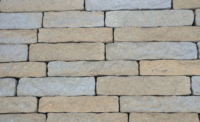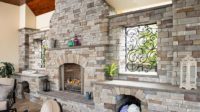Stone Veneer Presents a Rock-Solid Advantage
Stone veneer presents a rock-solid advantage to designers and contractors.


Commercial building design is increasingly taking a cue from the residential market as natural elements are used to convey a feeling of warmth and strength in exteriors, as well as interiors. Stone veneer is part of the trend—and that offers a rock-solid advantage to commercial and residential designers, installers and owners.
For designers, stone veneer offers broad design versatility, with a wide range of profiles, colors and accessories. Stone veneer installation can be completed faster and easier than full bed stone, offering time and cost benefits to building contractors. For owners, stone veneer presents an opportunity for a stone look, at a significantly lower cost than full bed stone. Additionally, stone veneer is a product that can help building professionals reach sustainability goals, and add the stylish appeal of masonry at any stage of the building’s lifecycle.
Here’s a closer look at factors driving the growing popularity of stone veneer and what’s trending in product preferences.
Mixing it up
Designers of both commercial and residential buildings continue to create unique exteriors by mixing cladding materials, colors and textures. For commercial structures, creative combinations of wood, glass, steel and masonry offer a way to express the unique identity and character of a company. Few materials can match the appeal of masonry in creating charm, projecting a feeling of strength, or conveying a welcoming warmth. Stone veneer provides the desired aesthetic and are virtually undistinguishable from full bed stone.
The stone look is increasingly extending beyond a structure’s walls into the outside environment. Matching stone pillars, columns, gates, archways and knee walls help create a continuous and unified design that enhances focal points and highlights special areas throughout a property.
Classic gives way to Contemporary
Contemporary style is currently trending in commercial and residential design, as well as in renovations. The look is smooth and sleek, with an emphasis on minimalism, open space and an absence of clutter. While stone is often associated with a traditional or classic design, new colors and profiles are perfectly in tune with the preference for modern lines and a look of urban sophistication.
Dry stack profiles are the clear preference for architects looking to create contemporary style. Gray and white are the trending colors. White offers a clean, crisp look, dark grays add character, and lighter gray shades are cool and calming. The stone veneer profiles most often chosen for today’s contemporary designs feature monochromatic coloring with subtle variations of a single shade, as well as profiles that feature a slight variation in color—for example, a predominantly gray pattern, with hints of light earth tones.
Bringing the Outdoors in
Open floor plans can be sparse and uninspiring. Office interiors can be cold and uninviting, and even the grandest of homes can lack elements that create a haven of comfort. Stone veneer is finding its way into all of these spaces, as designers recognize the benefits of bringing natural materials to interior spaces.
In the large expanse of an open floor plan, complete stone veneer walls and accents are being used to designate specific working or living areas. Commercial interiors are increasingly featuring stone walls throughout the work environment. While providing a beautiful aesthetic, this natural element can be calming, helping employees to relax and focus. In homes, stone veneer is finding its way beyond the typical fireplace to new, creative applications including accent walls, kitchen island surrounds, backsplashes and more.
Installation, Cost Drivers
Beyond aesthetics, architects, building owners and installation contractors are driving the growing popularity of stone veneer from a cost-and-time-saving perspective. Short construction timelines and tight budgets combined with the need to achieve high quality and design standards demand materials that can deliver on all counts.
While providing the look of full bed stone, stone veneer offers the advantage of easier installation, and lower costs. Stone veneer walls install quicker, requiring no wall ties or footings, enabling increased productivity and project efficiency. In addition to being less expensive compared to full bed stone, stone veneer is lighter in weight and less costly to ship.
A Step toward Sustainability Goals
Environmentally responsible building has moved from a trend to a mandate for many building professionals, and LEED certification has in many cases evolved from a goal to a requirement. Stone veneer has increased in popularity as they can contribute to these efforts.
Stone veneer may absorb less heat than other wall system cladding materials. They can provide insulation and improve the energy efficiency of exterior walls. Leading manufacturers produce veneers using pre-consumer recycled content. Additionally, depending on a project’s proximity to the manufacturer’s extraction and production locations, a stone veneer product may earn regional materials credits.
Rock on a Roll
With the growing popularity of stone veneer, it seems that this is one product that’s here to stay. In the world of building materials, stone veneer is an increasingly popular and literal rock star, one that can help keep design options, project timelines, cost reductions, installation efficiencies and sustainability goals on a roll. W&C
Looking for a reprint of this article?
From high-res PDFs to custom plaques, order your copy today!









